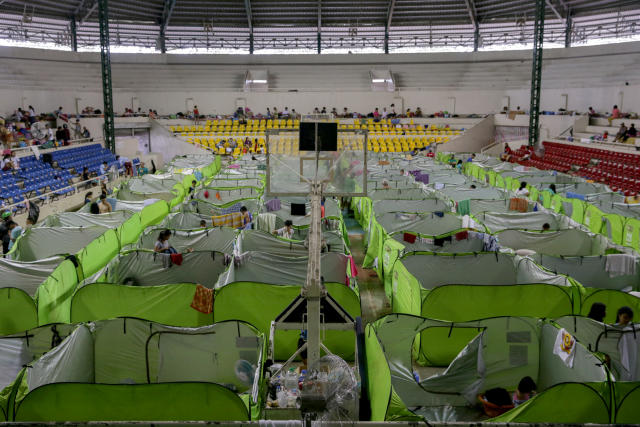OP-ED OPINION: Taal Volcano Is a Test of Philippines’ Disaster Plan – By Adam Minter

Smoke and ash erupted Sunday from the Taal volcano in the Philippines, with the plume rising almost 9 miles into the atmosphere and threatening hundreds of thousands of people. The Philippine government mobilized quickly. By Wednesday, more than 38,000 people were staying in evacuation centers, and many thousands more had dispersed to family throughout the country. Meanwhile, the government began to distribute supplies, including 100,000 protective face masks, in and around the eruption zone. There’s little time to waste: Volcanologists are warning that a hazardous eruption could come at any time.
Thanks to their planning, leaders in the Philippines hope that that eruption, if and when it comes, won’t be nearly as catastrophic as it would have been 10 years ago. Back then, the Philippines, like most emerging-market countries, mostly responded to disasters by cleaning up afterward. Today, preparedness is a national priority, and the Philippines is a model for how emerging-market governments in the world’s most disaster-prone region can be ready for the worst.

.
ADS by Cloud 9:
– SPACE RESERVE FOR YOUR ADVERTISEMENT –

–
Since 1970, 59% of the global death toll from disasters — about 2 million people — occurred in the Asia-Pacific region, according to a United Nations report. Economic losses have also been profound, totaling about $675 billion annually. The region’s disaster outlook is growing worse because of urbanization in vulnerable areas, degradation of the environment and the influence of a warming climate on extreme weather. In 2018, the Asia-Pacific region accounted for almost half of the world’s 281 natural disasters, and eight of the 10 deadliest. Already in 2020, at least 60 people died as a result of flooding in Jakarta, and tens of thousands remain in temporary shelters.
Thanks to its location, the Philippines is more vulnerable to disaster than its neighbors. On average, eight or nine tropical cyclones make landfall on its coasts annually, bringing storm surges, flooding and landslides — phenomena that are likely to become more frequent and intensify as the climate warms. The country is perched atop the “Ring of Fire” — a geologically active path along the Pacific Ocean — and is home to 53 active volcanos and fault lines capable of major earthquakes near the country’s biggest cities. Further raising the risk profile is the country’s drive to urbanize: Half the population currently lives in cities, with roughly a quarter of its residents (25 million people) in the Manila metro area.
.
ADS by Cloud 9:
– SPACE RESERVE FOR YOUR ADVERTISEMENT –

–
Officials in the Philippines historically didn’t view disasters as recurrent problems worth mitigating or preventing. Rather, their focus was almost entirely concentrated on rapid response after the disaster. That’s neither new nor uncommon in emerging Asian countries. In Jakarta, for example, the Indonesian government has struggled to manage regular, catastrophic floods, much less fund systems to control them. The situation has grown so bad that victims of this month’s floods are filing a class-action lawsuit against the government for failing to plan for them.
What changed the disaster calculus in the Philippines was the scale of the catastrophes. In 2009, metro Manilla was hit by Typhoon Ketsana, which dumped more than a month’s worth of rain in 12 hours, killed more than 700 people and paralyzed the city’s economy. The government’s tepid response precipitated a political crisis and the passage of legislation that prioritized proactive disaster management and risk reduction. Among other reforms, local governments are now required to prepare maps of areas prone to disasters like landslides, and make them public for planning and zoning purposes.

.
ADS by Cloud 9:
– SPACE RESERVE FOR YOUR ADVERTISEMENT –

–
To finance the shift, the country’s main disaster fund is mandated to spend 70% on prevention, preparedness and mitigation, with 30% allocated to quick response operations. Among other benefits, the funding enables local governments to invest in hazard monitoring and forecasting equipment, including tsunami detection stations and volcano observatories (including those watching the Taal volcano). This spending is mostly administered by local governments, but since 2010 their disaster responses are monitored, integrated and supervised by a high-level agency. This framework not only provides accountability, but also ensures that planning and response to large-scale disasters can be coordinated nationally. Civil society and religious organizations also play a grass-roots role in disaster planning and response.
Of course, no system is perfect. In the Philippines, it’s fair to question whether a disaster preparedness system that depends on forging consensus within and among communities can be effective in the event of a major crisis. Likewise, there are legitimate concerns that the government will not fund the system’s needs adequately. So far, at least, investments in detection and preparation have clearly left the Philippines in a better place to manage the disastrous impacts of an eruption at the Taal volcano than it was a decade ago. That’s a lesson that Indonesia and other disaster-prone Asian countries can afford to emulate.
© 2020 Bloomberg L.P.
.
ADS by Cloud 9:
– SPACE RESERVE FOR YOUR ADVERTISEMENT –

–
All photographs, news, editorials, opinions, information, data, others have been taken from the Internet ..aseanews.net | [email protected] |
For comments-Email to : Pahulu Gan| / [email protected]









